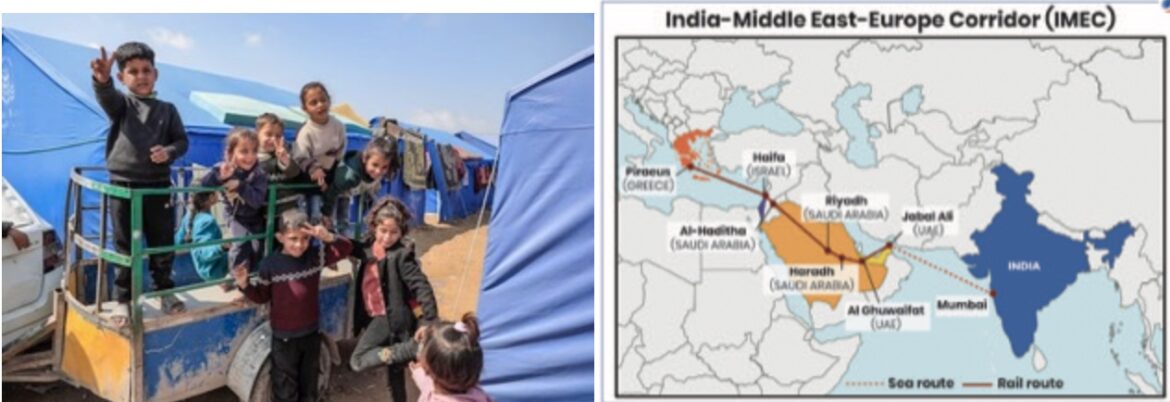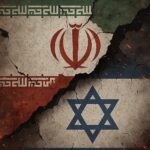For two years, the Middle East has been a case study in how conflict unravels even promising economic ideas. The India–Middle East–Europe Economic Corridor (IMEC), announced with fanfare at the New Delhi 2023 G20 Summit, was one such idea. It’s a modern, multimodal corridor linking Indian ports to the Gulf, overland through Arabia and Israel, and onward by sea to Europe.
But Hamas’s October 7, 2023 offensive on Israel and the war that followed froze the politics; missing rail links froze the economics. Momentum drained away as Arab partners recoiled from cooperation with Israel, Washington’s follow-up summit never materialized, and technical groups disbanded. By 2024, the project was nearly stillborn.
This week’s two developments, however, change the equation. Israel and Hamas have agreed to the first phase of a U.S.-brokered ceasefire with hostage releases, a staged Israeli pullback, expanded aid corridors, and a large prisoner exchange expected soon. This does not end the Gaza tragedy, but it opens diplomatic and logistical space that had been closed for nearly two years.
It is the most credible de-escalation since 2023, backed by Washington, which remains invested in IMEC’s future. Only weeks ago, Trump adviser Ricky Gill attended an IMEC meeting in New Delhi, underscoring bipartisan U.S. interest even as Washington pressed India with new tariffs.
At the same time, Saudi Arabia Railways has invited expressions of interest for a new Riyadh rail link that will run from the north of the capital to the south. The contract covers a 35-kilometre double-track line that connects the North–South Railway with the Eastern Railway, creating a continuous freight path through Riyadh. This link is designed as a key component of the Saudi Landbridge, a project valued at about $7 billion and planned to include more than 1,500 kilometres of new track.
Its core is a 900-kilometre line between Riyadh and Jeddah that will give the capital direct freight access from King Abdullah Port on the Red Sea. The rail link is poised to move the Landbridge from concept toward execution and strengthen the Saudi interior rail network.
Taken together, the ceasefire and Saudi rail move begin to chip away at IMEC’s two biggest constraints: political risk on the Saudi–Jordan–Israel leg and infrastructure gaps inside Saudi Arabia itself.
Why a Ceasefire Matters to a Corridor
IMEC’s “missing middle” runs through Jordan and northern Israel. Even before the Gaza war, the corridor assumed stable borders, predictable customs, and secure inland hubs such as Mafraq in Jordan and Beit She’an in Israel. The conflict rendered those assumptions untenable. A ceasefire does not resolve every challenge, since governance in Gaza and border security arrangements remain unsettled, but it lowers the risk premium that private investors attach to projects linked to Israeli or Jordanian logistics. IMEC was conceived with significant reliance on private capital, yet political instability has discouraged funders from committing.
A similar moment of optimism existed in 2024 when a ceasefire was announced, but it collapsed, and momentum evaporated. The difference now is that the current agreement appears more durable, creating renewed hope that this time the truce can hold, and financing can follow.
The truce also opens political space. It allows Saudi Arabia, Jordan, and Israel to re-engage on standards, data exchange, and security protocols without the constant fear of breakdown.
Finally, there is a sequencing effect. Cross-border infrastructure rarely attracts serious financing when conflict is active. If the ceasefire holds, with hostages released, partial withdrawals verified, and crossings reopened in a controlled manner, donor conferences and technical working groups can reconvene. That would accelerate due diligence on Jordan’s freight network and the critical Haifa connector. Analysts have long stressed that Jordan is the bottleneck; modest, targeted investment there could unlock the entire corridor.
Why the Saudi Landbridge Design Tender Matters
Some analysts view the rail push as primarily a response to Red Sea insecurity, but the design-tender signals a broader ambition. The Landbridge forms the kingdom’s interior backbone, shifting freight from Jeddah and King Abdullah Port through Riyadh to Dammam and on to northern routes.
The design-tender package immediately helps IMEC by making Saudi Arabia a bankable through-country for the rail leg. By hard-wiring Riyadh to both coasts and the North–South trunk, it creates commercial pull for additional westbound rail capacity, shortens transit times to Red Sea ports, raises reliability for Europe-bound flows, and turns the IMEC sea–rail–sea concept from a map exercise into an operational choice.
There is also a regional multiplier. The Gulf Cooperation Council Railway, about 2,000 km linking the six Gulf states, now targets 2030. Saudi Arabia’s internal network is the prerequisite for any credible Gulf freight flow. Without it, IMEC remains a map; with it, Saudi Arabia becomes a true transit hub.
India’s Stakes and the Framework Already in Place
For India, IMEC is not an abstract map; it is a strategic hedge against China’s Belt and Road Initiative (BRI) and chokepoints in Suez and Hormuz and a platform for energy and digital trade. India has concluded a free trade agreement with the United Arab Emirates and is negotiating with Qatar and the Gulf Cooperation Council.
In February 2024, India and the United Arab Emirates signed an Intergovernmental Framework Agreement, the only formal corridor step so far. The agreement commits both sides to develop a logistics platform with a digital ecosystem able to handle containers, bulk, and liquids. It is the legal anchor that allows IMEC to move from concept to operational planning.
During a recent visit to the United Arab Emirates, Commerce Minister Piyush Goyal noted that many new investments in the country are being planned with IMEC in mind and that countries along the corridor are reorienting infrastructure plans to integrate with it.
Why This Moment Is Different
IMEC has always been more than commercial math. It is a bet that connectivity reduces volatility and that route options give governments and firms resilience in a crisis. A working ceasefire lowers the political temperature enough to move from rhetoric to design. A Saudi rail program in procurement shifts the corridor from aspiration to logistics. Renewed United States attention and India’s attempts to keep the momentum through agreement with the United Arab Emirates and the recent New Delhi meeting of IMEC stakeholders signal that major players are still engaged.
With political barriers lowered, it is time to get to work, finalize Saudi designs, finance Jordan’s bottleneck, connect Haifa, and digitize borders. These steps are not glamorous, but they turn maps into markets.
On timing, the next G20 leaders’ summit is scheduled for Johannesburg next month under South Africa’s presidency; the United States is set to host the G20 in 2026. By the Johannesburg summit, we will know whether this week’s announcements were an inflection point or a footnote. With diplomacy thawing and infrastructure moving, IMEC has a window to move from shelved ambition to a functioning corridor.





